The Big Chute is the second to last of 43 locks along the Trent Severn Waterway on The Great Loop. The Big Chute is also the infamous roller coaster built for boats. I was looking forward to throwing my hands in the air and screaming as we went over the top … in honor of every other roller coaster I’ve ever ridden, but I was too busy holding the iphone videoing the descent. The videos are each less than 30 seconds and may or may not have been sped up or slowed down for visual effect. 🙂
Look closely in the bottom left corner of the photo below – as the boat roller coaster comes up one side, traffic gates come down to stop traffic so the coaster can cross the road!

World War I changed the course of construction for Lock 44, The Big Chute. It was planned as a conventional lock, but a lack of funding and manpower due to the war, caused it to be constructed as a marine railway instead – quicker, easier, cheaper. It was always scheduled to be rebuilt as a conventional lock… but ….
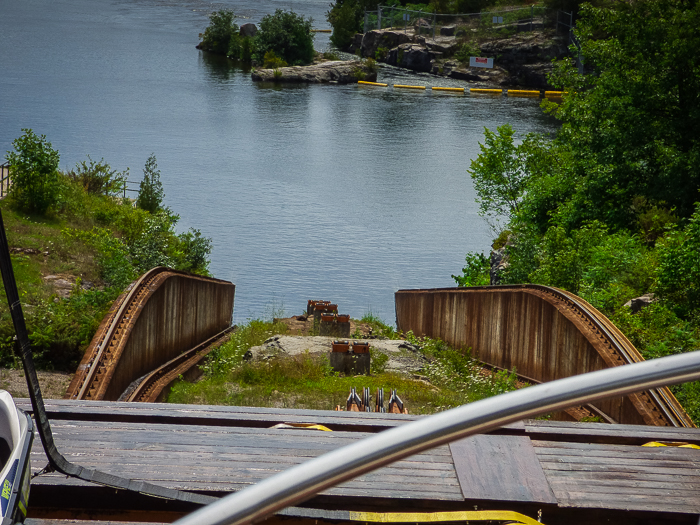
In the 1960’s the fishing industry was very concerned about an invasive species, sea lampreys, which were killing too many local fish. The fishing industry initiatives forced the conventional lock idea to be abandoned and a “permanent” construction of the current, larger marine railway.
A sea lamprey is a primitive eel like fish that attaches itself to other fish and sucks all their blood and no one wanted them in the lakes above the railway for obvious reasons.
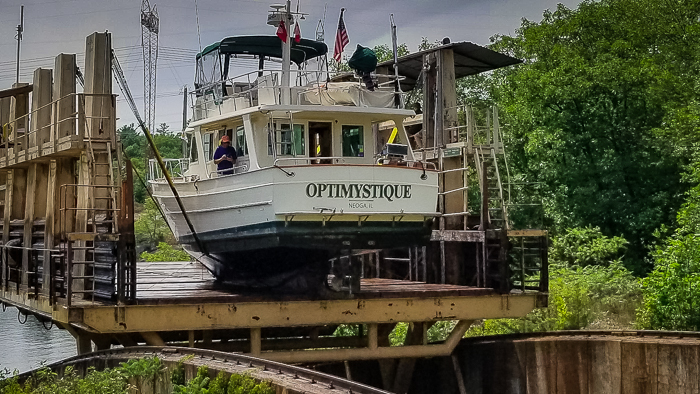
When we jumped off for a swim after the Big Chute – we commented about the water being so clear I could see a shark coming up to eat me. Sure is a good thing I didn’t know about blood sucking primitive eel like sea lampreys in the water! I might not have jumped in and it was HOT HOT HOT!
Before arriving at The Big Chute, we negotiated the second lift lock in the system, unfortunately it was raining (remember the first lift lock was Peterborough, the highest lift lock in the world, my post here).
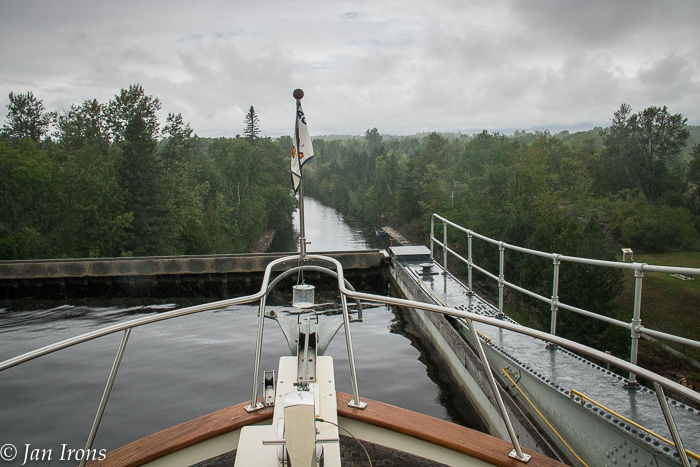
Kirkfield Lift Lock is the smaller sister (not younger, just smaller since it was built in 1907) and is the first lock LOWERING boats to the Lake Huron level. It operates on the same gravity “bathtub” system as Peterborough. But because you’re now going down, driving in appears like you’re driving your boat off the edge of the world!
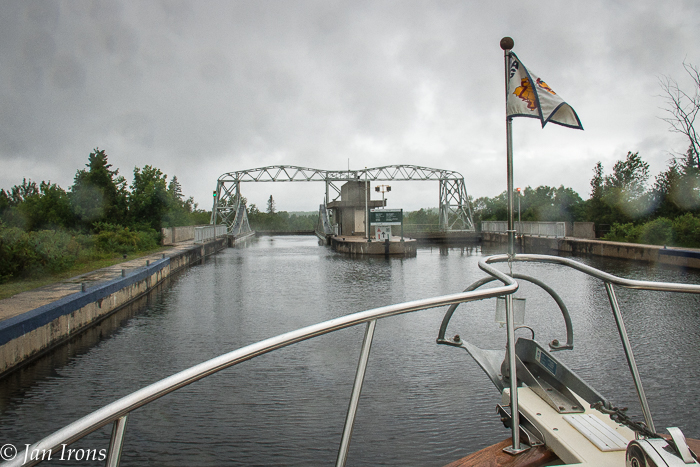
Unlike Peterborough which is built of unreinforced concrete, Kirkfield is entirely steel and “only” descends 49 feet as opposed to Peterborough’s 69 feet up. Unfortunately it was raining the day we went over Kirkfield so we don’t have the best photos – too busy trying to stay less than soaking wet.
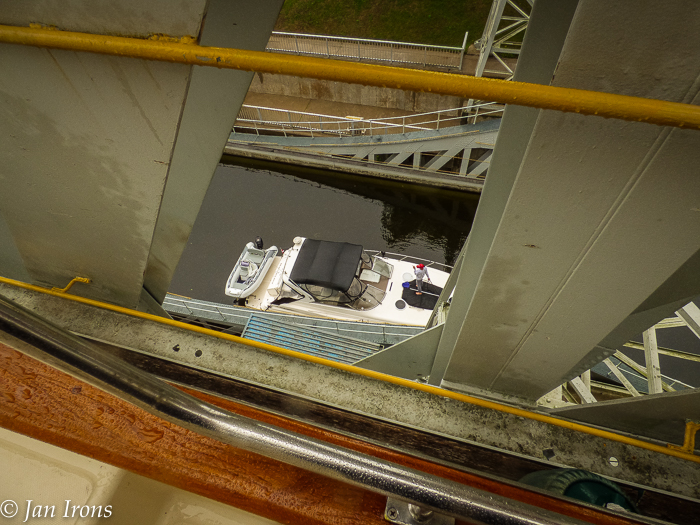
Did I mention that sometimes we were passed by interesting watercraft? We still don’t know what these two are riding for sure. Looks like a motorized wakeboard with a wristband which I assume shuts down the engine if you fall?

That next day we went down the Swift Rapids Lock – Swift Rapids is a modern, conventional lock completed in 1965. BUT it descends 47 feet (notice that a lift lock was necessary for the other two feet at Kirkfield).

The rules for the Swift Rapids Lock are different than other conventional locks. Other locks you loop your lines around the lock’s drop down lines fastened top and bottom and plastic coated. One end of the line (and sometimes both ends) can be fastened on a cleat but never tied to the lock’s drop down.

At Swift Rapids because there’s no way to stop the lock once it starts, they insist for safety that you hand hold both ends of your line looped around. It’s easier than it sounds, but I was worried with that big of lift it might be a bit turbulent in the lock and difficult to hold the lines. Not at all. It took all of 2 minutes and was very smooth.

Completing Lock 45 (the tiny original conventional lock at the very end of the Trent Severn Waterway), was our final lock for awhile … until we get to Starved Rock Lock southwest of Chicago.
Optimystique has successfully negotiated 88 locks on the Great Loop: 3 locks on the Okeechobee Waterway, 2 in the Dismal Swamp, 33 in our part of the Erie Canal, 7 in the Oswego Canal and 43 in the Trent Severn Waterway. No boat damage or people injured so it must be a success!
In case you missed any, there are 3 older posts on our Trent Severn Waterway canal saga:
240 Miles, 43 Locks: Trent Severn Waterway
Fun Facts About the Highest Lift Lock in the World, Peterborough Lift Lock
Sights of the Trent Severn Waterway
On to Georgian Bay & the North Channel. Reported to be the best fresh water cruising in the world! We’ll soon find out!
Any comments on the Trent Severn Waterway? Anything we should be sure not to miss in Georgian Bay or the North Channel? Please share! Cheers! Jan
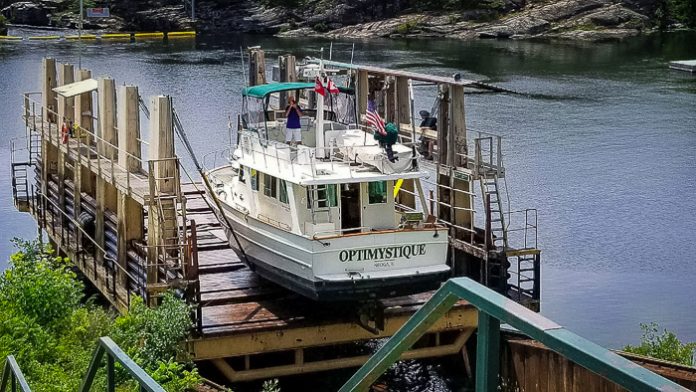













Very cool history lesson on Big Chute…..